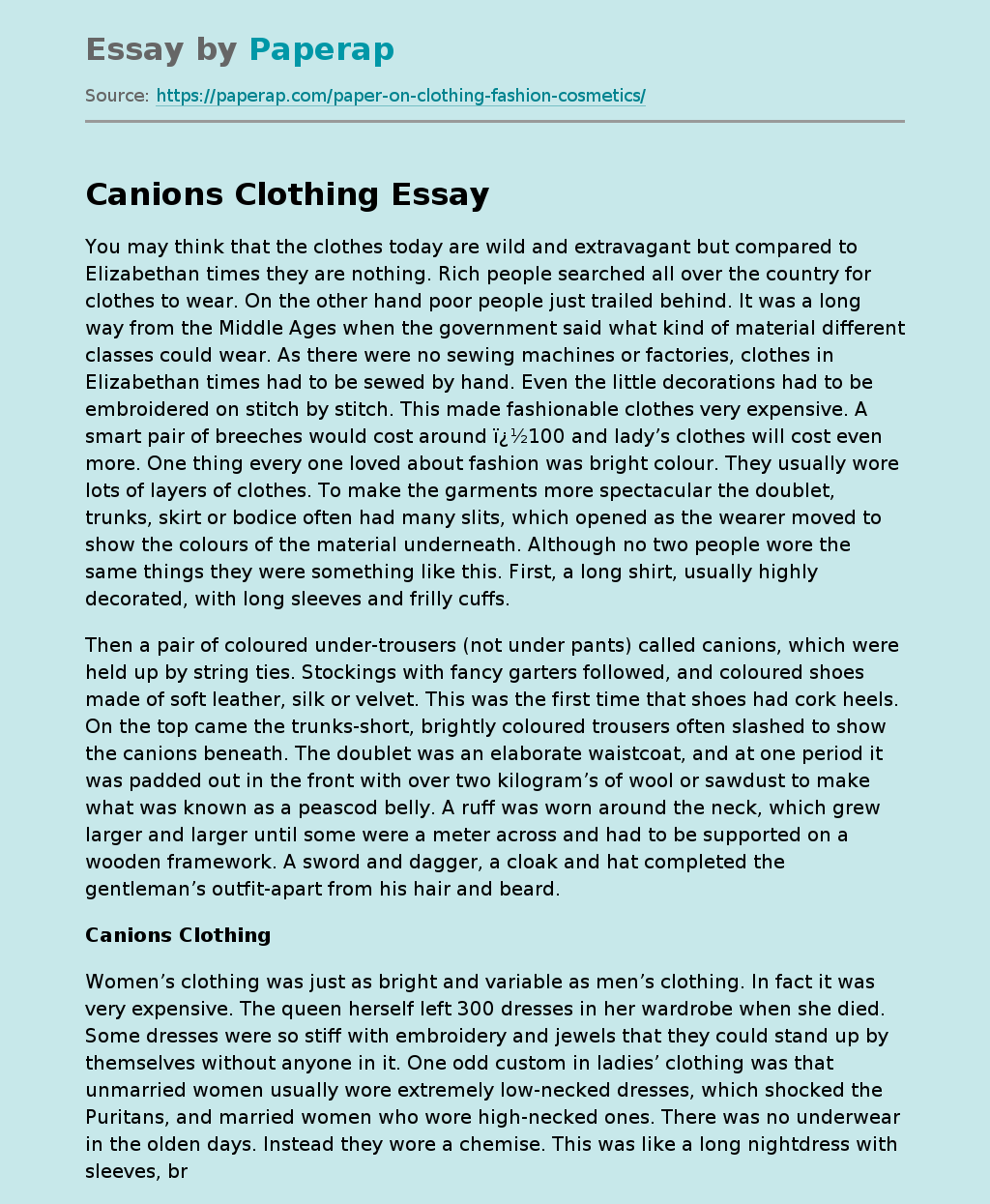Canions Clothing
You may think that the clothes today are wild and extravagant but compared to Elizabethan times they are nothing. Rich people searched all over the country for clothes to wear. On the other hand poor people just trailed behind. It was a long way from the Middle Ages when the government said what kind of material different classes could wear. As there were no sewing machines or factories, clothes in Elizabethan times had to be sewed by hand. Even the little decorations had to be embroidered on stitch by stitch.
This made fashionable clothes very expensive. A smart pair of breeches would cost around �100 and lady’s clothes will cost even more. One thing every one loved about fashion was bright colour. They usually wore lots of layers of clothes. To make the garments more spectacular the doublet, trunks, skirt or bodice often had many slits, which opened as the wearer moved to show the colours of the material underneath. Although no two people wore the same things they were something like this.
First, a long shirt, usually highly decorated, with long sleeves and frilly cuffs.
Then a pair of coloured under-trousers (not under pants) called canions, which were held up by string ties. Stockings with fancy garters followed, and coloured shoes made of soft leather, silk or velvet. This was the first time that shoes had cork heels. On the top came the trunks-short, brightly coloured trousers often slashed to show the canions beneath. The doublet was an elaborate waistcoat, and at one period it was padded out in the front with over two kilogram’s of wool or sawdust to make what was known as a peascod belly.
A ruff was worn around the neck, which grew larger and larger until some were a meter across and had to be supported on a wooden framework. A sword and dagger, a cloak and hat completed the gentleman’s outfit-apart from his hair and beard.
Women’s clothing was just as bright and variable as men’s clothing. In fact it was very expensive. The queen herself left 300 dresses in her wardrobe when she died. Some dresses were so stiff with embroidery and jewels that they could stand up by themselves without anyone in it. One odd custom in ladies’ clothing was that unmarried women usually wore extremely low-necked dresses, which shocked the Puritans, and married women who wore high-necked ones. There was no underwear in the olden days. Instead they wore a chemise. This was like a long nightdress with sleeves, brightly coloured and embroidered. Next came stocking made of cloth, silk or knitted ones. On top of the chemise came a leather belt in which the circular wooden framework or farthing hung from. The top one was slashed to show the under ones. The bodice was usually mounted on a corset of canvas stiffened with wood, metal or whalebone.
This pinched in the waist to make the skirt seem even wider than it was. For ladies who were having trouble with their measurements there were even all-metal corsets, which hinged down one side and locked on the other. The sleeves of the bodice were sometimes stiffened with wire to make them stand out. Unmarried women may wish to put a ruff around their neck. Finally, the Tudor lady smothered herself in jewels, especially pearls, carried scented gloves, a fan, a small mirror and possibly a pomander-a sweet smelling, spice-filled orange mounted in a silver holder to drown some of the evil smells.
As women today, Tudor ladies were fascinated by cosmetics, though they could not go into a chemist’s shop and see a dazzling array of neatly packaged and bottled perfumes and creams. Their cosmetics were usually homemade. Unfortunately, the Tudors were not over fond of washing, and it was said of Queen Elizabeth, as a great compliment to show how clean she was, that “she had a bath every few months, whether she needed it or not.”. The perfect Elizabethan beauty had a dead white face, neck and chest with sharply contrasting red lips and red spots on the cheeks. Her eyes had to be large and shining, with thin, arched brows. Her eyes had to be large and shining, with thin, arched brows. Teeth should preferably be white, but almost every woman after the age of twenty had several black and smelly stumps in her jaws.
Canions Clothing. (2019, Dec 05). Retrieved from https://paperap.com/paper-on-clothing-fashion-cosmetics/

